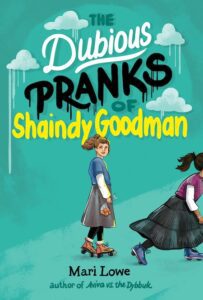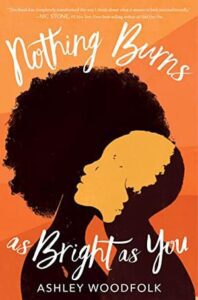Two Novels of Bad Friendships
The weather outside is dreadful, which means it’s a good day to stay inside and write a new blog post. Last month my daughter visited me for the holidays, and I shared with her a book that I’d just read, The Dubious Pranks of Shaindy Goodman by Mari Lowe. Maddy teaches fifth grade, which is a perfect age for this middle grade novel about how far an unpopular girl will go to have a friend. Shaindy’s family is part of an Orthodox Jewish community in a distant suburb of New York City, and a lot of the details are specific to the Jewish community, but the way the novel handles friendship is universal. That’s the beauty of this book. It transports most readers to another place and way of life while connecting with their familiar experiences and choices they may have made.
 Shaindy is one of those kids who isn’t good at anything, and not standing out in any positive way can be tough when one is in middle school and always being judged and graded. Her grades are mediocre, and she’s shy, with no real friends in her class, though she says all the girls there are “nice.” She’s clumsy and thus avoids the Heely roller skates that all her classmates own. The fact that her family has less money than many others is an issue as well. Across the street lives Gayil, the most popular girl in the class, and a favorite of the teachers as well. Gayil has always ignored Shaindy beyond the pleasantries that lead Shaindy to say that the girls are “nice.”
Shaindy is one of those kids who isn’t good at anything, and not standing out in any positive way can be tough when one is in middle school and always being judged and graded. Her grades are mediocre, and she’s shy, with no real friends in her class, though she says all the girls there are “nice.” She’s clumsy and thus avoids the Heely roller skates that all her classmates own. The fact that her family has less money than many others is an issue as well. Across the street lives Gayil, the most popular girl in the class, and a favorite of the teachers as well. Gayil has always ignored Shaindy beyond the pleasantries that lead Shaindy to say that the girls are “nice.”
In truth, those girls anything but nice to each other. One evening Gayil holds a sign in her bedroom window for Shaindy to see, asking Shaindy to meet her outside. Shaindy jumps at the opportunity to possibly become a friend of the most popular girl in the class. Who wouldn’t? Even when Gayil enlists Shaindy to help carry out pranks against her closest friends, Shaindy doesn’t question her. After all, the prank seems harmless. (It ultimately results in the friend having to chop off her hair.) And when they’re not pranking their classmates, Gayil is teaching Shaindy to roller skate. It’s not like Gayil is using her. She’s really being a friend, right? Even though she never invites Shaindy to hang out with her other friends?
As kids go through elementary school, friends become ever more important, and so do choices about friends. Gayil has her reasons for being a bad friend. Her family is very large, and she fears getting lost. However, that doesn’t excuse the way she uses Shaindy (a perfect example of “breadcrumbing”), nor does the fact that Shaindy is lost and alone excuse the choices she makes to gain Gayil’s attention and approval.
 There are many ways of being a bad friend, or getting involved with a bad friend, and the relationship between Shaindy and Gayil is only one of them. Sometimes two kids are fine when apart from each other, but when they get together, bad things happen. This kind of toxic relationship is at the heart of a YA verse novel I recently read, Ashley Woodfolk’s Nothing Burns as Bright as You. Two Black girls meet in a coffeeshop early on in high school. One is from a close family; the other’s mother, a hardworking professional, gives her a lot of independence. They are both queer — one bisexual, the other attracted only to girls. This creates tension in a relationship that veers back and forth between friendship and romance. That tension is part of what makes the two unnamed girls engage in activities (both together and separately) that get them into trouble with their families and at school, such as sneaking out, staying out all night, sassing teachers, and going to drinking parties at an unfinished housing development in the woods. When their parents try to break them up, it only draws them closer together, as they see themselves as united against a common enemy.
There are many ways of being a bad friend, or getting involved with a bad friend, and the relationship between Shaindy and Gayil is only one of them. Sometimes two kids are fine when apart from each other, but when they get together, bad things happen. This kind of toxic relationship is at the heart of a YA verse novel I recently read, Ashley Woodfolk’s Nothing Burns as Bright as You. Two Black girls meet in a coffeeshop early on in high school. One is from a close family; the other’s mother, a hardworking professional, gives her a lot of independence. They are both queer — one bisexual, the other attracted only to girls. This creates tension in a relationship that veers back and forth between friendship and romance. That tension is part of what makes the two unnamed girls engage in activities (both together and separately) that get them into trouble with their families and at school, such as sneaking out, staying out all night, sassing teachers, and going to drinking parties at an unfinished housing development in the woods. When their parents try to break them up, it only draws them closer together, as they see themselves as united against a common enemy.
In fact, all trouble draws them closer together, which makes them bad friends, at least for each other. And ultimately, that trouble leads to a spree of fire setting that will force them to make hard choices for their future and their freedom to live in their community. The fact that the protagonists are Black makes them more vulnerable in and out of school, but it also means that their common experiences draw them to each other and offer emotional refuge from a world that doesn’t get them. There aren’t many Black kids in their community. Yet their friendship and their choices do resonate universally. These are not bad kids. They have strong relationships with their families as long as the other friend is not involved. They get good grades and have contributed to school activities.
Just as Shaindy learns that the answer to her problems is not a friendship with someone who uses her but someone who is a genuine friend, the two protagonists of Nothing Burns as Bright as You are in the process of figuring out who they can turn to for support and help. This is important for any teenager because all teenagers struggle to various degrees on the journey to becoming an adult. It’s a tough journey. The perils are greater for kids who are marginalized for whatever reason, and especially for girls who are Black and queer. This is why we need books like Nothing Burns as Bright as You, and why efforts to ban these books are particularly cruel and counterproductive.






